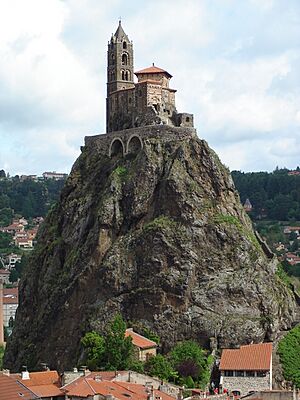Volcanic plug facts for kids
A volcanic plug is a special type of landform. It forms when hot, melted rock (called magma) cools down and hardens inside the opening, or vent, of a volcano. Imagine a volcano like a giant pipe. If the magma inside that pipe hardens, it creates a solid block. This block is the volcanic plug. People sometimes call them volcanic necks or puys.
Over a very long time, the softer rock around the hard volcanic plug gets worn away by wind, rain, and ice. This process is called erosion. When the surrounding land erodes, the tough volcanic plug is left standing tall, often looking like a lonely tower or a steep hill.
When a volcanic plug is forming, it can trap a lot of gas-filled magma underneath it. This can build up huge amounts of pressure. Sometimes, this pressure can cause a very powerful and explosive volcanic eruption. But if the eruption doesn't happen, the volcano's vent becomes a solid, hard block of rock.
The rock that makes up a volcanic plug is usually much harder than the rocks around it. Because of this, it resists erosion better. Sometimes, glaciers (huge sheets of ice) can erode one side of the plug, leaving a long, gentle slope of material on the other side. This creates a landform known as a crag and tail. If the plug stays strong, erosion will remove the weaker rock around it, leaving the plug as a distinct, tall landmark.
Contents
Famous Volcanic Plugs
Many famous landmarks around the world are actually volcanic plugs. These tall, strong rock formations have often been used to build castles or fortresses because they are naturally protected and hard to attack.
- Edinburgh Castle in Scotland is built on top of an ancient volcanic plug.
- Devils Tower in Wyoming, United States, is a very well-known volcanic plug.
- Shiprock in New Mexico, United States, is another striking example.
- The Piton mountains in Saint Lucia are also volcanic plugs.
How Volcanic Plugs Form
Volcanic plugs are created through a process that takes a very long time.
Magma Hardening
When a volcano is active, magma flows up from deep inside the Earth. This magma can fill the main vent and any cracks (fissures) around it. If the volcano stops erupting, the magma inside the vent cools down slowly. As it cools, it turns into hard, solid rock. This solid rock acts like a cork, plugging up the volcano's opening.
Erosion Reveals the Plug
After the magma hardens, the volcano itself might become inactive. Over millions of years, weather, wind, and water slowly wear away the softer outer layers of the volcano. This erosion removes the ash, lava flows, and other less resistant rocks that made up the volcano's cone. Because the rock of the plug is much tougher, it resists this erosion. Eventually, the plug is left standing alone, towering above the surrounding landscape.
Related Landforms
Volcanic plugs are a type of intrusion. An intrusion happens when magma pushes into existing rock layers and then cools and hardens underground.
Images for kids
See also
 In Spanish: Cuello volcánico para niños
In Spanish: Cuello volcánico para niños
















